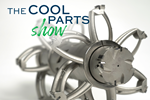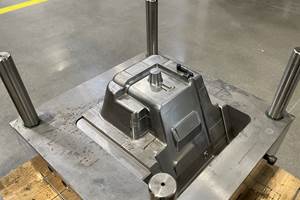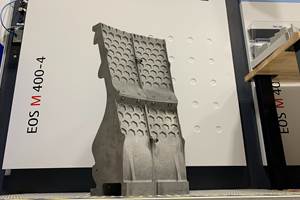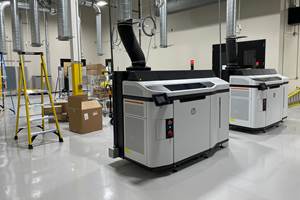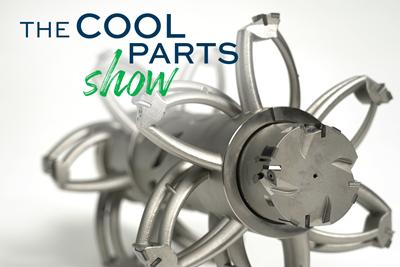Transportation component maker Voith formerly used cutting tools that were nearly too heavy for its CNC machining centers in a boring operation for transmission housings of large vehicles. Inspired by a generatively designed cutting tool for machining the stator bore of electric motors, Voith turned to cutting tool maker Kennametal to develop a cutting tool for its application made using generative design for lightweighting along with 3D printing to produce the resulting form. The new tool is less than half the weight, reducing the maintenance needs of the machine using it while also allowing Voith to decrease machining cycle time because of the faster acceleration of the tool.| This episode of The Cool Parts Show brought to you by Carpenter Additive
The Cool Parts Show is a video series from Additive Manufacturing Media that explores the what, how and why of unusual 3D printed parts. Watch more here.
Have a cool part to share? Email us.
Related Resources
- Voith
- Kennametal stator bore tool, seen on The Cool Parts Show
- Additive manufacturing capability at Kennametal
- Articles on generative design
- More of what we saw at Formnext 2022
- Get our new newsletter, The BuildUp
Transcript
00:00:00:09 - 00:00:00:20
Pete Zelinski
I'm Pete.
00:00:01:06 - 00:00:01:22
Stephanie Hendrixson
I'm Stephanie.
00:00:01:22 - 00:00:10:07
Pete Zelinski
Welcome to The Cool Parts Show Bonus Episode. Stephanie, I want to do a follow up. Do you remember the episode we did about the Kennametal stator bore tool?
00:00:10:07 - 00:00:33:12
Stephanie Hendrixson
Yeah. So that was a tool for cutting these bores in motor housings for electric vehicles. And if I recall, the issue was that the user wanted to be able to make that cut all in one go, but doing that with a conventional cutting tool, the tool would have been too heavy for their machinery. And so Kennametal was able to develop and design this 3D printed tool that was lightweighted and able to do that job.
00:00:33:14 - 00:00:59:10
Pete Zelinski
And it looked strange because it was made through generative design. And I have got an even weirder 3D printed cutting tool. The manufacturer using this tool is Voith, in Germany. They make transportation parts. The part this tool is used on is a big transmission housing. Think like for vehicles, like busses, this tool machines a large precise bore in that housing.
So the tool that we're seeing, it spins very rapidly inside of a machining center so that it can precisely cut the diameter, actually varying diameters, of that big hole.
00:01:10:17 - 00:01:16:20
Stephanie Hendrixson
Okay. So this is starting to sound familiar. Was this cutting tool 3D printed for some of the same reasons as that other one.
00:01:17:14 - 00:01:24:14
Pete Zelinski
Actually? Yeah. So this tool was also developed by Kennametal and it was inspired by that stator bore tool you described.
00:01:24:23 - 00:01:25:16
Stephanie Hendrixson
That's pretty neat.
00:01:25:23 - 00:01:51:06
Pete Zelinski
One difference is that Voith has actually been machining this transmission housing for quite a long time and they have been machining it using a more conventionally designed, large, boring tool. So a much heavier tool. And the way Voith was dealing with this is they were just accustomed to frequent maintenance on their machine tool resulting from using this oversize over heavy cutting tool.
They saw the stator bore tool. They knew the lightweighting that it achieved could really help them, too. So this tool was also generatively designed for lightweighting within their boring application. And so where that original tool was like 30 kilograms, this new tool is just 11 and a half kilograms much lighter, and four and a half kilograms alone is for the tool holder, not even the tool, but the holder that holds it in the machining center.
00:02:21:06 - 00:02:36:15
Stephanie Hendrixson
That's pretty significant weight savings. But I'm looking at this and I'm wondering if there are other similarities with that previous tool that we highlighted. One of the features of that stator bore tool was there were actually coolant lines through that crazy geometry to take coolant to the cutting edges. Is that happening here too?
00:02:37:00 - 00:03:28:23
Pete Zelinski
It is. But yes, this is a messy geometry. One thing about generative design, it does not care about realizing a visually tidy form. It just mathematically tries to optimize around the parameters you give it, toward the goal you set for it. And the objective here was lightweighting, but also, yeah, in combination with delivering coolant through the inside of this crazy form to send high pressure coolant to all of those different cutting edges to push chips out of the way as machining occurs. I should say the inserts themselves, the cutting edges are not 3D printed, they are polycrystalline diamond, PCD precisely mounted on the tool and also similar to the stator bore tool, it's actually precision machining multiple diameters at once. One pass hits a sequence of different diameters because different sets of those cutting edges are mounted at different diameter sizes along the span of the tool.
00:03:44:15 - 00:03:50:17
Stephanie Hendrixson
So a lot of really interesting things going on with this tool. But where are they with this right now? What benefits are they realizing?
00:03:51:06 - 00:04:16:23
Pete Zelinski
Benefits, increased machine availability because there's less downtime for maintenance now and also more productivity because the cycle time for this operation is reduced, partly because the more lightweight tool it's possible to accelerate it faster up to its cutting speed, decelerate it back down when it's done. The result is the cycle time for this cut is half what it used to be.
00:04:17:11 - 00:04:24:17
Stephanie Hendrixson
All right, that's it for this bonus episode of The Cool Parts Show. If you want to see our full episode on that stator bore tool, check out the links in the show description.
00:04:25:05 - 00:04:39:06
Pete Zelinski
Thank you to my sources I talked to about this tool, Friedrich Oberlaender of Voith and Werner Penkert of Kennametal. I spoke to them at the recent Formnext show to see what else I saw at that show, I'll put a link in the show description.
00:04:39:14 - 00:04:40:08
Stephanie Hendrixson
Thanks for watching.
Related Content
8 Cool Parts From Formnext 2024: The Cool Parts Show #78
End-use parts found at Formnext this year address various aspects of additive's advance, notably AM winning on cost against established processes.
Read MoreDaimler, OMIC Evaluate Wire-Fed DED for Moldmaking
3D printing a core and cavity on machine from Gefertec, followed by machining, allowed for a complete mold tool to be produced in three days.
Read More3D Printed Spares, Electrification and Cool Parts: Top 10 Stories of 2022: AM Radio #31
Our top articles and videos from 2022 reflect increasing use of additive manufacturing for replacement parts; growing applications for electric motors; and a maturing user base. Read through the top 10 list or listen to the AM Radio podcast episode all about these stories.
Read MoreWhat Does Additive Manufacturing Readiness Look Like?
The promise of distributed manufacturing is alluring, but to get there AM first needs to master scale production. GKN Additive’s Michigan facility illustrates what the journey might look like.
Read MoreRead Next
3D Printed Tool for Machining Electric Vehicle Motors: The Cool Parts Show #39
Additive manufacturing achieves a large-diameter cutting tool light enough for fast, precise machining of the motor housing’s stator bore.
Read MoreAlquist 3D Looks Toward a Carbon-Sequestering Future with 3D Printed Infrastructure
The Colorado startup aims to reduce the carbon footprint of new buildings, homes and city infrastructure with robotic 3D printing and a specialized geopolymer material.
Read MoreCrushable Lattices: The Lightweight Structures That Will Protect an Interplanetary Payload
NASA uses laser powder bed fusion plus chemical etching to create the lattice forms engineered to keep Mars rocks safe during a crash landing on Earth.
Read More


